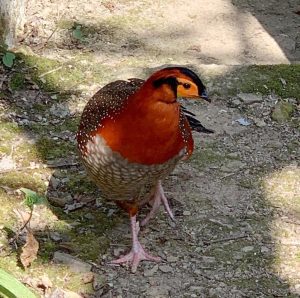Nagaland
Blyth’s tragopan: Plight no more as conservation efforts take flight

Muzhaba Jamir
Dimapur, July 14 (EMN): While Nagaland continues to strive for wildlife conservation in a broader scale, it is also engaged in increasing efforts to help flourish the population of its state bird: Blyth’s tragopan.
In the past, excessive hunting and deforestation had brought this bird’s population to near extinction in the state. Now, it is listed as a Schedule-I bird in the Wildlife Protection Act of 1972. This means that the bird needs complete protection.
Penalties for hunting the bird include three years in jail along with fines not less than INR 5000. For second or subsequent offence, the prison term may extend to six years and the monetary penalty, INR 10,000.
About the bird
Blyth’s tragopan (scientific name: Tragopan blythii) or the grey-bellied tragopan is a pheasant whose breeding and nesting season is between March to May while the incubating period is for 28-35 days. Its nests are found in trees, stumps, and small bushes, usually in an abandoned nest of another species. They prefer wooded areas, undergrowth of evergreen forests, and other dark, quiet places. They are also found in densely wooded valleys and hillsides.
Blyth’s tragopan is an omnivorous bird, which feeds on various types of seeds, berries, fruits, ferns, buds, fresh leaves, fleshy and succulent/tender vegetative shoots as well as ants, insects, snails, worms, beetles, pebbles, and small frogs.
They live in small groups or in pairs, and is believed to be primarily monogamous. They roost in trees, singly or in pairs except during nesting. These birds are secretive, shy and suspicious of humans, and are quick to hide amongst the dense vegetation they inhabit, if disturbed.
According to Forest officials, the bird is mainly found in the colder and hillier eastern zone of the state like the Japfü range, Dzükou valley and Khonoma in Kohima district, Pfutsero and Meluri in Phek district, the foothills of Saramati, Fakim Wildlife Sanctuary and Noklak in Tuensang district, and Mount Pauna and Benreu in Peren district. Recently, the bird was also sighted at Puliebadze, Jotsoma, they said.
While talking to Eastern Mirror, the state’s Principal Chief Conservator of Forests and Chief Wildlife Warden, Dr. Ramesh K Aima, explained that the bird is being conserved via two different methods, that is, ex-situ and in-situ conservation.
Ex-situ conservation
In ex-situ conservation, a few of these birds are kept at a breeding centre called the ‘Tragopan Conservation and Breeding Centre’ located in Kohima. It was established in 2012 and was earlier known as Old Kohima Zoological Park.
“This centre is placed at the top of the hill so that they (the birds) will get the least disturbance,” said Aima and assured that the department is trying to breed and give the birds the best possible means of food and care.
Though the conservation is successful, the breeding process is very difficult. It was reported that rarely two eggs are laid in a year and only one chick manages to mature. “There are various reasons affecting the process, maybe the place is infertile or it may be because of the diet,” conceded Aima.
The director of Nagaland Zoological Park (NZP) and the in-charge of the breeding centre, Dr. Prabhat Kumar, told Eastern Mirror that there are currently 14 Blyth’s tragopans as breeding stock—eight male and six female. He informed that the Tragopan Conservation and Breeding Centre is a “satellite family” of the NZP.
According to the director, tragopans are very sensitive birds, which makes the process of making them breed complicated. One of the main reasons is that some males and females do not find themselves compatible to mate.
“There is a particular season for breeding. Problem arises when even in that season, the birds do not mate as they don’t find themselves compatible,” he sighed. “The idea of the breeding centre is to release the birds into the wild once they reach a good number. So we are trying our best to increase its population,” he added.
Talking about the improvement of the breeding programme, the chief wildlife warden said that the department is planning to install a number of closed-circuit television cameras around the conservation area. Being very shy creatures, it is difficult for the officials to examine the bird’s lifestyle. “If you approach them, they tend to run away,” he said.
The purpose of installing the cameras is to get an insight into their normal lifestyle. “By installing the cameras, we can see exactly how they live, what they do during the day, and where the problems lie. It will improve our management to some extent,” he added.

